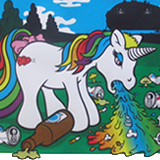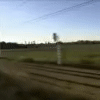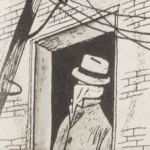|
That's a great film. Getting that steel down to Birmingham so they can make Austin 1100s.
|
|
|
|

|
| # ? May 10, 2024 00:12 |
|
I love the combination of ridiculously high tech (punch tape! electrohydraulic external speed controls! giant electromagnets!) with the fact that dudes are still hand humping poo poo in to box cars and no one has yet figured out that having some kind of standard for material handling and doing sideloading might be clever.
|
|
|
|
meltie posted:A really interesting snapshot of a small slice in time - modernising goods yards, electric vehicles and computerised dockets... but all the goods are still breakbulk. Fascinating. And most of those high-tech marshalling yards (planned under BR's 1955 Modernisation Plan) were functionally obsolete from the moment they were built. Tinsley never operated at its designed capacity - by 1966 the decline in the coal and steel industries and the rise of road transport were already doing a number on industrial rail traffic - and by 1975 large sections were standing idle. And the idea of a central concentration yard for the Sheffield area had been proposed multiple times since the 1890s but the private competing rail companies could never agree on where it would go, who would operate it and who would pay for it, and each guarded their own slice of the traffic. One other bit of insanity people unfamiliar with British railways may not know: the majority of those wagons going into Tinsley have no air or vacuum brakes - just the handbrake operated from the ground. When formed into a train none of the wagons contribute any braking force - the driver has the locomotive brakes and the guard has the brakes on the brake van at the rear and that's it. The guard would usually leave the van brake dragging slightly to keep the chain couplings taught. Prior to the 1950s the majority of British freight trains were like this, made up of 10-15ton rigid two-axle wooden-bodied wagons and vans trundling around the network with essentially no brakes at no more than 30mph. At the top of steep gradients the train would stop and the guard would go along and 'pin down' the handbrakes on enough wagons to just hold the train on the gradient, and the loco would drag the whole lot down the slope against the brakes, then stop at the bottom so the brakes could be released. BR made a big push to modernise freight traffic in the 1950s, building on developments in the 1930s where dedicated express freights were run at up to 50mph using long-wheelbase wagons with driver-controlled vacuum brakes. BR started building thousands of steel-bodied mineral wagons - the majority were 'unfitted' (no brakes) but a portion were vacuum-brake fitted. On a train of 30-odd wagons there would be six brake-equipped wagons at the front to help stopping power. At the same time more general freight was being carried in vans rather than wagons, and these were nearly all brake-fitted. BR settled on a colour scheme were all un-fitted rolling stock was painted grey and braked stock was red-oxide. So all those little grey wagons at Tinsley are basically the same tech as a mine cart from the 1810s. With the advent of containerisation and the near-total death of general wagon-load freight in the 70s BR began building bigger freight wagons with air brakes that could run at 60mph or more, but a lot of the older collieries could only handle the little short-wheelbase box wagons (which in turn is why that design remained in use for so long - Catch-22) so right into the 80s there were still trains in the UK running around with unbraked wagons hd together by three-link chains under the control of a guy at the back with a big manual crank-wheel, just like in the 1840s.
|
|
|
|
KYOON GRIFFEY JR posted:I love the combination of ridiculously high tech (punch tape! electrohydraulic external speed controls! giant electromagnets!) with the fact that dudes are still hand humping poo poo in to box cars and no one has yet figured out that having some kind of standard for material handling and doing sideloading might be clever. Speaking of Modernisation, the Youtube rabbit hole brought me to these two reports, 1959: https://www.youtube.com/watch?v=V-s4acBHIFU and 1961: https://www.youtube.com/watch?v=fhYA4dNhxaE Seeing some of the NW stations is fascinating, East Didsbury & Manchester Oxford Road still look like they do here
|
|
|
|
BalloonFish posted:This poo poo train has no brakes. Welp, I always knew British trains were poo poo, I just didn't realize HOW poo poo. The idea of no air brakes in 1950 is loving mindboggling to me. The US figured that poo poo out in the 1800's.
|
|
|
|
Disgruntled Bovine posted:Welp, I always knew British trains were poo poo, I just didn't realize HOW poo poo. The idea of no air brakes in 1950 is loving mindboggling to me. The US figured that poo poo out in the 1800's. Even today they only have freight cars with single axles.
|
|
|
|
Vincent Van Goatse posted:Even today they only have freight cars with single axles. That's very definitely not the case.
|
|
|
|
Blacknose posted:That's very definitely not the case. But they still use chains and those bumper things to hook them together.
|
|
|
|
https://www.youtube.com/watch?v=6lMyxZgVEKk WARNING : Includes Mime
|
|
|
KYOON GRIFFEY JR posted:I love the combination of ridiculously high tech (punch tape! electrohydraulic external speed controls! giant electromagnets!) with the fact that dudes are still hand humping poo poo in to box cars and no one has yet figured out that having some kind of standard for material handling and doing sideloading might be clever. forklifts or hand trucks are still how boxcars are loaded. in the 1950s, the economics of upgrading the entire railroad from chain couplings and manual brakes to automatic couplers and air/vacuum/electronic breaks in the face of increasingly competitive trucking firms and decreasing british manufacturing dont really make sense. Disgruntled Bovine posted:Welp, I always knew British trains were poo poo, I just didn't realize HOW poo poo. The idea of no air brakes in 1950 is loving mindboggling to me. The US figured that poo poo out in the 1800's. this is kind of interesting question. the british created a standard earlier than the us did. so, the us standard is comparatively more modern. likewise, the russians created a standard much later than either.
|
|
|
|
|
don't see too many box cars out there these days though
|
|
|
|
vains posted:this is kind of interesting question. the british created a standard earlier than the us did. so, the us standard is comparatively more modern. likewise, the russians created a standard much later than either. Not entirely sure what you mean. The US was standardized on friction brakes actuated from roof-top brake wheels and link and pin couplers up until the late 1800's. The change-over pretty much happened around the same time between 1890 and 1905.
|
|
|
|
Disgruntled Bovine posted:Not entirely sure what you mean. The US was standardized on friction brakes actuated from roof-top brake wheels and link and pin couplers up until the late 1800's. The change-over pretty much happened around the same time between 1890 and 1905. I think vains is getting at the point that the reason British trains were so backward in many ways was that the UK railway system was virtually mature by the 1850s. All the national industrial infrastructure - the movement of raw materials from the pit to the mill, the transport of processed material from the mill to the factory, and the shipment of the finished product from the factory to market - was up and running and had been built around thousands of low-capacity unbraked wagons rolling around at low speeds, being continually marshalled into larger trains and then split up into shorter ones during their journey. The collieries were built with lightly-laid, tight-curve sidings designed to cram exactly the number of 10-ton two-axle wagons needed to carry a day's production and no more, the loading stages were built for the small wagons and so on right through the system. Once that's all in place it becomes prohibitively expensive and difficult to change since the network already has a universal standard. Especially when the network is owned by multiple private companies in fierce competition with each other and the governments of the era are very much against top-down enforcement. The railways always wanted to adopt larger wagons that could carry more and travel faster, since it was clearly more efficient.The problem was that the railway customers were extremely reluctant to upgrade the facilities at their end because they bore little of the cost caused by the inefficiency of the current system. And many of the coal loading/unloading equipment at collieries, steel mills, factories, docks, power stations and so on would damage a wagon fitted with continuous braking gear and many collieries in South Wales for instance had sidings so tightly packed and so curved that undercarriage braking gear would fould lineside equipment such as points switches and signal rods. With every element of the system being owned by a different private corporation and with the system working 'well enough' as it was, there was never going to be the consensus or force needed to change. So the unbraked little box wagons continued. The two railway companies that enjoyed the closest monopoly over Britain's two biggest coal-producing areas - the Great Western Railway in South Wales and the North Eastern Railway in north-east England - both leveraged their monopoly by insisting that if the coal mine owners wanted to get their product out to market they would have to do so in larger, faster wagons. Both companies were able to strong-arm their way to using 20-ton hoppers, although still two-axle and unbraked. British passenger trains adopted continuous brakes at around the same time as they did in America - the mid-1870s. Here the preciptating cause was the Abbots Ripton rail crash, one of the major contributing factors of which was the poor braking available - the handbrake on the loco, two or three brake vans along the train and, in extremis, reversing the loco itself. This led to the Board of Trade recommending - it was not able to legally require at this stage - continuous brakes be fitted to passenger trains. There was no guidance or consensus on what sort, and various system were in use by various companies. Most favoured 'straight' vacuum brakes (where vacuum was generated to apply the brakes), which had the big problem of any failure of the system or breakage of the vacuum pipe rendered the brakes inoperable. Vacuum was favoured because of its simplicity - vacuum was produced by a steam ejector with no moving parts which could run continuously and the brake force could be easily varied simply by adjusting a valve connecting the ejector to the train pipe. Other railways favoured the 'straight' air brake, using positive air pressure. This was faster-acting and slightly more powerful but harder to regulate and required a more complicated and expensive steam-powered air compressor. Mechanical systems using connected lengths of chain under each carriage were tried and found wanting, as were various hydraulic-based designs. Only a couple of railways adopted the Westinghouse automatic air brake system from America, where positive air pressure held the brakes off and thus were 'fail safe'. The shortcomings of the 'straight' vacuum system were shown in the Armagh Disaster of 1889 when a train stalled on a steep climb. The crew separated the train into two sections to take up the hill in turn. When the train pipe was separated the vacuum was lost from the rear section and the inadequate handbrakes let that half of the train roll down the hill, where it collided with an oncoming train causing the deaths of 80 people. Government legislation was then introduced which required all passenger trains to be fitted with brake systems that were both continuous and automatic. As was the way with British railways of the era, the independent companies took this opportunity to gently caress with each other as much as possible by - with few exceptions - deliberately refusing to use the same braking system as their neighbours. Most went for an automatic vacuum system (which was still cheaper and more user-friendly, if slightly less effective) but a large minority went for the Westinghouse air system. Take the railways heading out of London, starting from the due north/12 o'clock position and going clockwise: Great Northern: vacuum Great Eastern: air London, Tilbury & South End: vacuum London, Chatham & Dover: air South Eastern: vacuum London, Brighton & South Coast: air London & South Western: vacuum Great Western: vacuum (but a unique system that wasn't fully compatible with other vacuum brakes) London & North Western: vacuum Midland: vacuum The East Coast Main Line was operated jointly by three companies - the two at each end (Great Northern and North British) used vacuum brakes while the one in the middle (North Eastern) used air. The London & North Western operated the English part of the West Coast Main Line with vacuum brakes while the Caledonian Railway ran the Scottish part of the WCML with air brakes. So all ECML and WCML passenger stock had to be dual-fitted with both braking systems. Some carriages were fitted with their home-company's brake system and then 'through-piped' for the other, so a GNR carriage would have vacuum brakes but also an air pipe running from end to end so it could be coupled in between air-braked carriages and the brakes on those would still worked - regulations permitted a certain portion of carriages without working brakes in this way. Under such a haphazard system freight wagons, which could roam quite extensively around the national network across multiple company's lines, could not conceivably be fitted with both braking systems. Another form of uniquely British madness in this era was that the majority of freight cars were owned by the company whose goods were being transported, not the railway company running the train. So there were literally thousands of parties involved in any attempt to standardise any aspect of freight operations and they all had a vested interest in keeping things as cheap and simple as possible. The private owners had to be cajouled into fitting their wagons with proper telescopic buffers rather than 'dumb' wooden blocks and axle bearings lubricated by oil rather than grease. Getting them to adopt a braking system, or a stronger and safer coupling mechanism, would have been virtually impossible. This is why no real change happened until everything was nationalised in the 1940s - British Railways now owned all the rolling stock including over 1.5 million freight wagons of various sorts, of which only around 10 per cent were fitted with any sort of continuous braking system and virtually all of them were still twin-axle short-wheelbase types. The coal and steel industries and the major port authorities were also nationalised, theoretically making it easier to introduce much-needed modernisation. This started with slightly larger (16-ton) steel-bodied wagons and vans, of which around a third would be vacuum-brake fitted (the pre-nationalisation companies had finally standardised on vacuum brakes in the 1920s) and this was followed by a general push to eliminate unfitted freight trains on all but mineral traffic by 1970. As the old pre-war stock was retired, it was replaced by new designs of brake-fitted freight cars with longer wheelbases capable of running at higher speeds (up to 70mph, where the previous limit for brake-fitted wagons had been 45mph and for unfitted wagons it was 25mph) and with screw-type coupling chains which could be adjusted for less 'slack', reducing the in-train forces and making them more controllable. When continously-welded rail was introduced to BR on a wide scale during the 1960s as another part of its modernisation, there followed a significant surge in derailments by the twin-axle freight rolling stock, especially the old short-wheelbase stuff. This was never properly explained - some suggested it was due to the new diesel and electric locomotives being able to apply more sudden and greater force to the couplings than the steam locos. Some blamed the increasing fitment of continuous brakes, which set up in-train forces that the wagons and their buffers and couplings were never designed for. The most prevalent theory was that the old bolt-jointed rails, due to the gaps between the rail sections and the rhythmic jolting this provided to the wagons, served to damp out other forces in the train. On the CWR this force was absent so forces and motions built up over time, especially unwanted pitching in the short-wheelbase wagons and vans, until the car jumped off the rails. In the early 70s BR introduced a new form of its 'Speedlink' wagonload freight service, called Speedlink ABN (for 'Air Braked Network'). This guaranteed next-day delivery between a designated system of freight depots around the country. To acheive this the trains had to run at 70mph and this required a fleet of dedicated wagons and vans, with an even longer wheelbase and new suspension. As the name implied, the only way to gain the required braking force to safely run trains at this speed was by adopting air brakes. By this time the coal industry was also being reformed with redeveloped pitheads to accept 'merry-go-round' trains - fixed-formation trains which could be loaded and unloaded while still moving at walking pace. This removed the need to couple and uncouple the individual wagons, making it practical to fit the new HAA 32-ton coal hoppers with continuous brakes, and again air brakes were chosen. I believe the last loose-coupled unfitted mineral trains (with a brake van and no continuous brakes on the wagons) and the last vacuum-braked freight train both ran on BR in the same year - 1992.
|
|
|
|
That was fascinating, thank you for taking the time to write all that out!
|
|
|
|
I have the nerdiest possible question for the thread: Can anyone recommend a railway-based board game? I want to worry about logistics, coal supplies and gauge mis-matches. (Also excellent post BalloonFish.)
|
|
|
|
Ticket to Ride Not sure what boardgame would have guage conversation.
|
|
|
|
Pocket Trains by Nimblebit (on mobile) has been a great time waster for me. Single player, though.
|
|
|
|
Wow Balloonfish, thank you for that epic tale of crap British trains. I can't believe they ran trains without airbrakes up into the 90s. The US had some of the same problems regarding lack of standardization, however I think the combination of longer heavier trains and more severe terrain to cross motivated them to make the change. Crossing the rocky mountains with a train that required brakemen to walk the roofs of the cars in blizzard conditions and subzero temperatures to set hand brakes on each car to descend 2-3% grades is not a problem the UK had to deal with.
|
|
|
|
Glad people liked my history-of-crap-brakes post  Didn't intend for it to be that long but it's such a web of linked factors that it kept going! Didn't intend for it to be that long but it's such a web of linked factors that it kept going!Disgruntled Bovine posted:Wow Balloonfish, thank you for that epic tale of crap British trains. I can't believe they ran trains without airbrakes up into the 90s. The US had some of the same problems regarding lack of standardization, however I think the combination of longer heavier trains and more severe terrain to cross motivated them to make the change. Crossing the rocky mountains with a train that required brakemen to walk the roofs of the cars in blizzard conditions and subzero temperatures to set hand brakes on each car to descend 2-3% grades is not a problem the UK had to deal with. Indeed not. The distances involved certainly helped - there's a huge time advantage in the US of being able to run freight trains at 40+ mph over hundreds of miles which require decent brakes. Those distances also encourage fewer but heavier trains, and your much bigger loading gauge permits suitably powerful locomotives to pull them. One thing I didn't mention earlier was that one thing BR did in its early days was introduced 'Windcutter' trains on the former Great Central mainline. A large part of the line's traffic was moving coal from Nottinghamshire and south Yorkshire into London. Local trains would collect coal from the individual mines and go to the marshalling yard at Annesley, where the wagons would be assembled into long trains to go down the line to Woodford Halse, 70 miles to the south where they'd be split up again for local delivery. To improve capacity BR decided to make use of the fact that the Great Central had been engineered with long, shallow gradients and, after a few experiments, allowed the running of unfitted coal trains at express passenger speeds  Imagine 40 or more 16-ton mineral wagons, all without brakes and coupled by three-link chains, all being dragged over jointed rails by a Class 9 steam loco at 60+ mph, with a poor guy in the brake van at the back (also rigid frame and only two axles...) trying to keep it all under control! Imagine 40 or more 16-ton mineral wagons, all without brakes and coupled by three-link chains, all being dragged over jointed rails by a Class 9 steam loco at 60+ mph, with a poor guy in the brake van at the back (also rigid frame and only two axles...) trying to keep it all under control!
|
|
|
|
Tree Bucket posted:I have the nerdiest possible question for the thread: I assume 18XX series is a bit too financially focused for you but if you haven't checked that out you should.
|
|
|
|
Tree Bucket posted:I have the nerdiest possible question for the thread: Kreez fucked around with this message at 16:15 on Jul 1, 2020 |
|
|
|
BalloonFish posted:Imagine 40 or more 16-ton mineral wagons, all without brakes and coupled by three-link chains, all being dragged over jointed rails by a Class 9 steam loco at 60+ mph, with a poor guy in the brake van at the back (also rigid frame and only two axles...) trying to keep it all under control! Nope.
|
|
|
|
Tree Bucket posted:I have the nerdiest possible question for the thread: Not sure it's quite as nerdy as you want, but they've remade The Great Game of Britain:  You get given a number of destinations to visit before returning to London ahead of the other players, but everyone has a token to close a station. Also if you change lines (I think this is pre-nationalisation so LNER -> LMS for instance at Carlisle) you have to take a hazard card. If it's anything like the original (still played every Christmas at home) they'll be things like "Enticed to fish; go to Grimsby" or "Sheepdog trials; all players congregate in Perth" - these are exceptionally annoying if you're taking a hazard card to get the ferry to the Isle of Wight. JingleBells fucked around with this message at 20:25 on Jul 1, 2020 |
|
|
|
BalloonFish posted:Great Western: vacuum (but a unique system that wasn't fully compatible with other vacuum brakes) LMAO of course God's Wonderful Railway went "Sod you, we know best".
|
|
|
|
Itzena posted:LMAO of course God's Wonderful Railway went "Sod you, we know best". The GWR system ran at 25" of vacuum (achieved via both a steam ejector and a reciprocating pump driven off the locomotive's valve gear) while all the others ran at about 20". So if a GWR engine was taken off a cross-country train and replaced by another company's loco the new engine sometimes wouldn't be able to get the brakes fully off as there'd still be 5" or so of air pressure in the system. It's hard to think of a single thing the GWR didn't have weird practices about - track gauge, rail profile, vacuum brakes, headcodes, whistle signals, power classification, loco numbering, headlamp colour, brake van design, pannier tanks, putting the signals on the left of the rails but the driver on the right of the loco, adding assisting engines behind the lead loco rather than just sticking them on the front, insisting on all the carriage corridors being on the same side of the train, thus requiring brake coaches to be built in symmetrical left- and right-hand versions and all the other poo poo.
|
|
|
BalloonFish posted:words about british trains yeah, i wasn't really clear and i dont know enough facts about british rail, american rail or russian rail to compare. i do know, for example, the british trains(and i guess european trains) used until somewhat recently chain/bumper couplers, where the us uses the janney coupler, and the russians use something even more advanced.
|
|
|
|
|
vains posted:and the russians use something even more advanced. Which reminds me of a chart that absolutely blew my mind, courtesy of donoteat and his crew;  "Oh yes, America is too spread out and sparsely populated for passenger rail to work."
|
|
|
|
NoWake posted:Which reminds me of a chart that absolutely blew my mind, courtesy of donoteat and his crew; Well in Russia it's either a nice warm train, or a long cold walk through deadly wilderness, so it's no surprise it's popular there  . .
|
|
|
|
NoWake posted:Which reminds me of a chart that absolutely blew my mind, courtesy of donoteat and his crew; Of course the Russians have more KM than us, we don't use that crap, we use miles! This sounds like communist talk to me.
|
|
|
|
vains posted:yeah, i wasn't really clear and i dont know enough facts about british rail, american rail or russian rail to compare. Sweden uses buffer and chain for most freight trains and loco-hauled passenger trains. EMUs are usually Scharfenberger with varying degrees of interoperability - the Stockholm commuter EMUs X1 from the 60s and X10 from the 80's would run in mixed consists with 4 X1 and 4 X10 wagons and just switch directions at the end. Stockholm's new subway cars and most of the new tram cars are Schaku's as well. LKAB's iron ore trains from Kiruna to Narvik use the Soviet automatic SA3 coupler
|
|
|
|
JingleBells posted:Not sure it's quite as nerdy as you want, but they've remade The Great Game of Britain: Oh wow, this dredged up memories of some boardgame our family once had that was based on the London Underground. ninja edit: Aha, it was literally called The London Game. I always wondered what was at Putney Bridge, and it turns out now I have the internet, not much is!
|
|
|
|
BalloonFish posted:The GWR system ran at 25" of vacuum (achieved via both a steam ejector and a reciprocating pump driven off the locomotive's valve gear) while all the others ran at about 20". Is that why Duck (the GWR) is invariably such an enormous
|
|
|
|
Schadenboner posted:Is that why Duck (the GWR) is invariably such an enormous It's been years and years, but IIRC the basic arc of Duck's first appearance is him learning to stop being a tedious jerk going on at everyone how the GWR did everything better, and that he has to learn to adapt, fit in with the Sodor engines and be Really Useful. I think the stereotype of GWR enthusiasts (and, in the day, employees) being overly smug about 'their' railway's uniqueness goes back a long way, even before Awdry started writing the Railway Series. At least back to the Gauge Wars in the 1840s.
|
|
|
|
BalloonFish posted:It's been years and years, but IIRC the basic arc of Duck's first appearance is him learning to stop being a tedious jerk going on at everyone how the GWR did everything better, and that he has to learn to adapt, fit in with the Sodor engines and be Really Useful. The absolute cattiness of British Rail Culture shines through in every bit of Thomas media BVMTH consumes (which is a lot). Also they're racist af against diesels.
|
|
|
|
Sodor locomotives racist against diesels? Explains a lot, tbh.
|
|
|
|
Minto Took posted:Sodor locomotives racist against diesels? Explains a lot, tbh. The first diesel to appear in the books was a BR standard shunter, imaginatively called Diesel. Since shunting was Duck's job he was told to show Diesel around and introduce him to the Sodor trucks and their ways. Duck immediately dislikes Diesel on principle, thrn rapidly gets tired of him always boasting about how much better he is than the steam locos (an irony that Duck doesn't recognise and I doubt was deliberate on Awdry's part...) and fucks off without teaching Diesel anything. Diesel makes an honest but ineffective attempt to shunt the trucks (because Duck didn't help him) and is made a laughing stock. In revenge he starts a chain of rumours and gets all the other engines to turn on Duck before he is found out and sent away in disgrace. Duck and Diesel both behave like massive assholes but only one of them is a prejudiced rear end in a top hat...but they're not the one made out to be the bad guy. There's a later story where another diesel loco turns up and is also shunned and bullied by the Sodor locos...until he proves himself. I'm sure they literally call him 'one of the good ones.' And that's without getting into all the symbolism of how the trucks (which carry the revenue-earning freight but have no agency) all speak in British working class dialects, are always being difficult and need a firm, controlling hand from their betters...and the two which agitate for change in the existing order get literally destroyed - one by being pulled in half and the other deliberately crushed. The underlying politics of the Railway Series (and the Rev. Awdry) are really lovely once you start looking around/behind the stories.
|
|
|
|
Yeah, but... Steam locomotives ARE better than diesels.
|
|
|
|
Better at being complete poo poo, maybe?
|
|
|
|
also Diesel the character was a black class 11. If we're getting into racism.
|
|
|
|

|
| # ? May 10, 2024 00:12 |
|
BalloonFish posted:The first diesel to appear in the books was a BR standard shunter, imaginatively called Diesel. Since shunting was Duck's job he was told to show Diesel around and introduce him to the Sodor trucks and their ways. Duck immediately dislikes Diesel on principle, thrn rapidly gets tired of him always boasting about how much better he is than the steam locos (an irony that Duck doesn't recognise and I doubt was deliberate on Awdry's part...) and fucks off without teaching Diesel anything. Diesel makes an honest but ineffective attempt to shunt the trucks (because Duck didn't help him) and is made a laughing stock. In revenge he starts a chain of rumours and gets all the other engines to turn on Duck before he is found out and sent away in disgrace. You can see why he has such a grumpy face:  All he wanted was to be accepted.
|
|
|
































